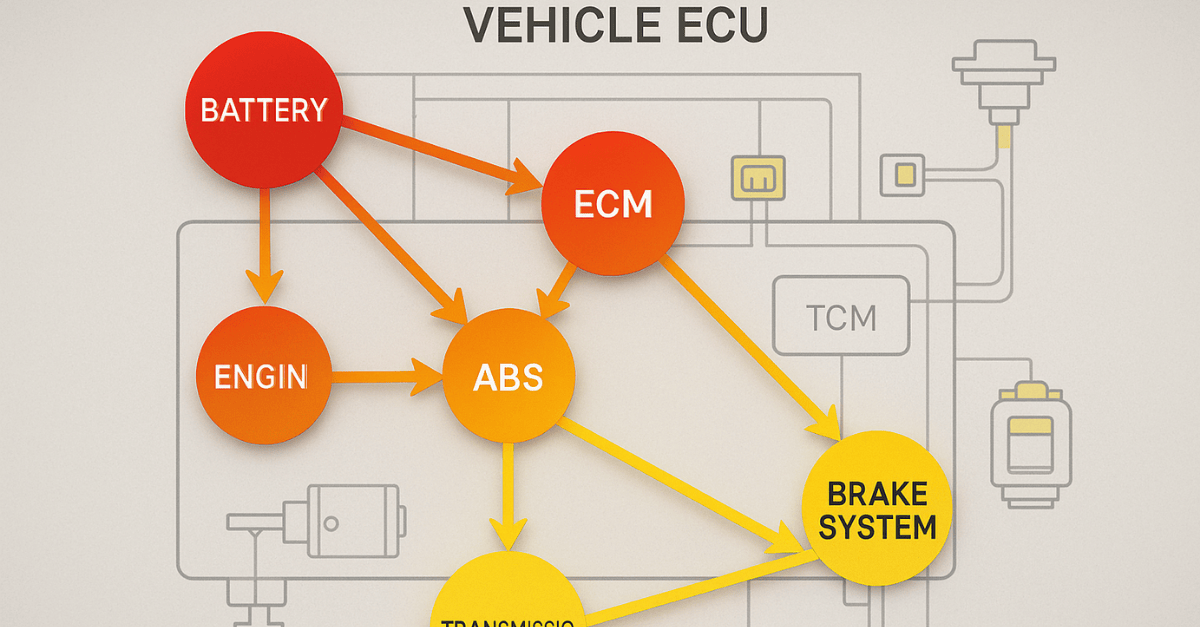
Modern fleet vehicles have evolved into complex networks of interconnected electronic systems, with dozens of ECUs (Electronic Control Units) and hundreds of sensors communicating over specialized digital networks. While this evolution has enabled remarkable improvements in vehicle performance, efficiency, and safety, it has also created significant challenges for maintenance teams. Traditional diagnostic approaches struggle to identify the root causes of system failures when multiple interrelated components generate cascading error codes. This case study examines how advanced causal modeling techniques—specifically Granger causality analysis—were implemented to revolutionize fault detection in a large commercial fleet, resulting in dramatic improvements in diagnostic accuracy and vehicle reliability.
Interstate Logistics Corporation (ILC), a national freight carrier operating throughout the Midwest and Eastern United States, managed a diverse fleet of 230 commercial vehicles. The company had recently invested in next-generation vehicles with advanced driver assistance systems, electronic stability control, and optimized engine management to improve safety and fuel efficiency.
While these technological advancements initially delivered the expected benefits, the maintenance team began experiencing a troubling trend: complex, intermittent electrical and sensor issues that standard diagnostic tools couldn't reliably identify. These issues typically manifested as inconsistent error codes across multiple systems, leading to extensive and often unproductive diagnostic sessions.
By early 2024, the situation had become critical. The fleet was experiencing an average of 18 diagnostic "mystery cases" per month, with vehicles spending an average of 3.7 days in the shop for diagnosis. In several instances, vehicles had been returned to service after component replacements, only to experience the same issues days later. Each misdiagnosis was costing approximately $840 in unnecessary parts and labor, plus an estimated $1,200 per day in lost productivity.
ILC faced several specific challenges with their in-vehicle network diagnostics:
After evaluating several approaches, ILC implemented a sophisticated diagnostic system based on Granger causality modeling. This statistical concept, originally developed for economic analysis, tests whether one time series can be used to forecast another time series. In vehicle network diagnostics, this translates to determining which sensor or system anomalies precede and potentially cause other failures.
The solution was built around three core capabilities:
The solution was implemented through a multi-layered approach:
The system was deployed through the FleetRabbit platform, which provided the necessary data infrastructure for capturing network traffic, the analytical engine for causal modeling, and the integration with existing maintenance management systems.
The implementation followed a structured approach spanning 20 weeks:
After eight months of operation, the Granger causality-based diagnostic system delivered significant improvements:
in identifying root causes of complex network faults
in diagnostic time for intermittent electrical issues
in avoided misdiagnoses and reduced vehicle downtime
in repeat repair visits for the same issue
in average diagnostic time for complex cases
The system proved particularly effective at identifying:
In many cases, weak causal relationships that consistently appeared in the correct sequence were more diagnostic than strong correlations without clear temporal ordering.
Different vehicle systems exhibited unique temporal characteristics in fault propagation, requiring system-specific lag windows for Granger testing.
Temperature, humidity, and vibration data were essential for normalizing causal relationships across different operating conditions.
Building multi-level causal chains (A causes B causes C) rather than just pairwise relationships dramatically improved diagnostic clarity.
Subtle changes in message timing and frequency often preceded official error codes by hours or even days.
The most valuable insights frequently came from establishing causality between traditionally isolated systems (e.g., how a subtle electrical issue affected both engine and braking systems).
Beyond the immediate diagnostic improvements, ILC experienced broader operational benefits:
This application of Granger causality to vehicle network diagnostics demonstrates how advanced statistical methods can solve previously intractable maintenance challenges. As vehicles continue to increase in complexity, simple threshold-based diagnostics will become increasingly inadequate, making causal modeling approaches essential for efficient maintenance operations.
For fleet operators struggling with complex, intermittent network issues, this case highlights the potential for significant operational improvements through advanced diagnostic methodologies. Rather than treating each subsystem in isolation, causal approaches recognize the interconnected nature of modern vehicles and provide a more holistic diagnostic perspective.
Fleet managers interested in implementing similar approaches can leverage platforms like FleetRabbit that provide the necessary data infrastructure and analytical capabilities for advanced causal diagnostics across diverse vehicle fleets.
The implementation of Granger causality analysis for in-vehicle network fault detection represents a significant advancement in fleet maintenance capabilities. By understanding the temporal and statistical relationships between system behaviors, this approach enables maintenance teams to cut through the complexity of modern vehicle networks and identify true root causes with unprecedented accuracy.
The 94% diagnostic accuracy achieved through this approach demonstrates that even the most complex intermittent issues can be systematically resolved through appropriate causal modeling. As vehicle systems continue to grow in complexity, similar approaches to understanding system interdependencies will become increasingly essential for efficient fleet operations.
This case study illustrates how techniques originally developed for economic forecasting can be successfully adapted to solve pressing challenges in vehicle diagnostics, creating substantial operational and financial benefits while extending the useful life of sophisticated fleet assets.